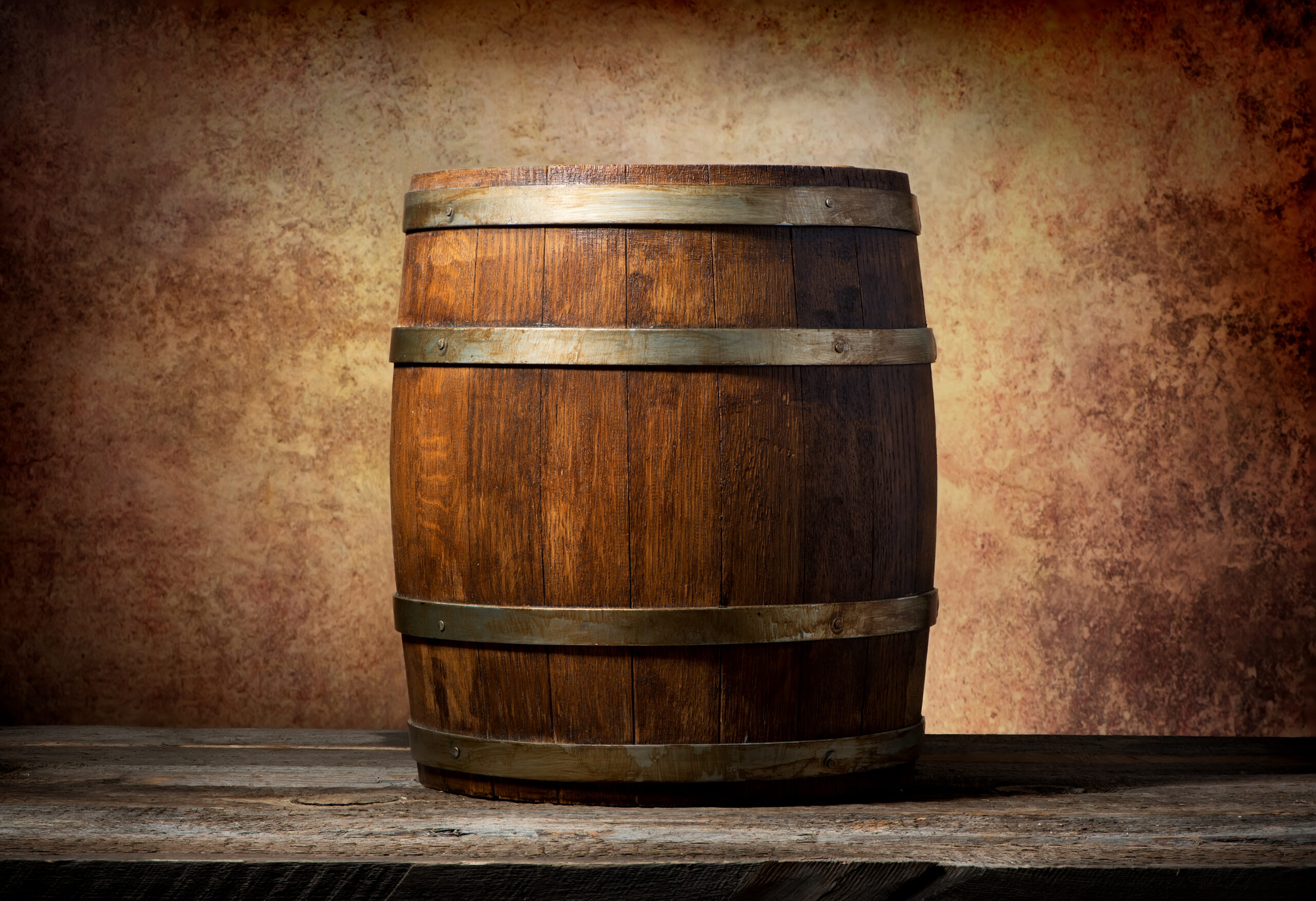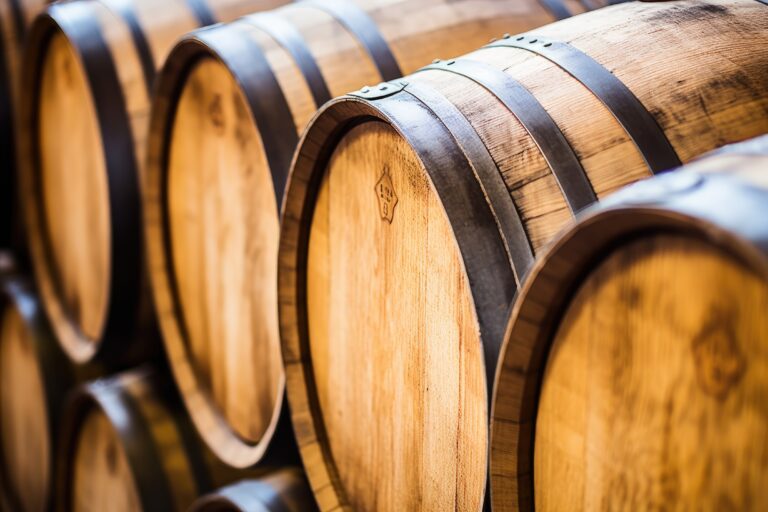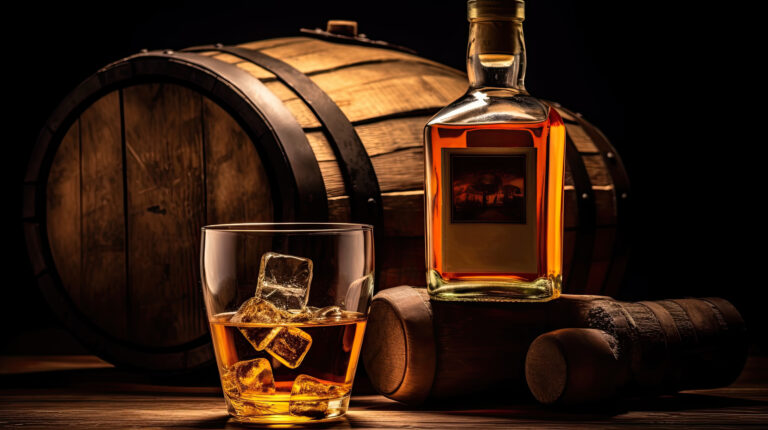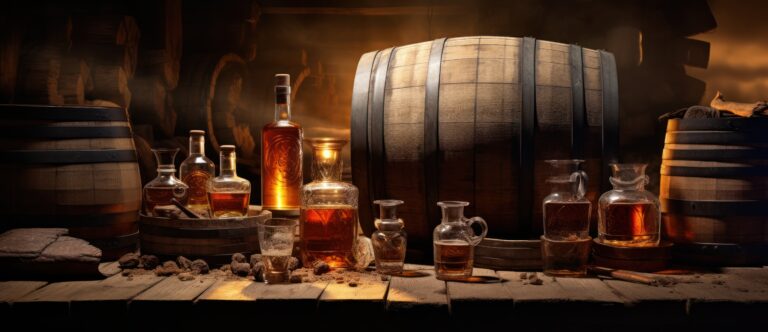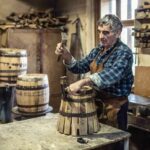Have you ever wondered why your favorite whiskey tastes the way it does? It’s not just about the distillation process. A huge part of a whiskey’s character—its color, aroma, and flavor—comes from the barrel it was aged in. These barrels, also known as whiskey casks, are more than just containers; they are essential to crafting the spirit we know and love. By understanding how they work, you’ll gain a deeper appreciation for the nuanced world of whiskey.
What Exactly is a Whiskey Cask?
At its core, a whiskey cask is the vessel used to mature whiskey. Traditionally crafted from oak, these barrels come in a variety of types, but the most common are made from American white oak or European oak.
The type of oak and its previous use are crucial. For instance, by law, bourbon must be aged in new, charred oak barrels. This process gives bourbon its signature notes of vanilla and spice. In contrast, Scotch whisky is often aged in used barrels that previously held spirits like bourry and sherry. These used sherry casks impart nutty, dried fruit flavors, while ex-bourbon casks lend hints of caramel and coconut.
Barrel size and age also play a role. Smaller barrels have more wood-to-spirit contact, which speeds up the maturation process. Conversely, older barrels impart less flavor, requiring a longer aging period to achieve the desired taste. This careful selection of the right cask is vital to developing the distinctive flavors of various whiskey types, including bourbon, Scotch, Irish whiskey, and rye.
So, the next time you enjoy your favorite whiskey, take a moment to appreciate the humble cask—the unassuming container that’s instrumental in creating that warm, amber elixir. Its wood and unique history combine to give each whiskey its characteristic color, aroma, and taste.
The History of Whiskey Cask Aging
The practice of aging whiskey in casks has a rich history spanning centuries. Initially, distillers used casks out of pure necessity for storage and transportation. However, they soon realized that aging their spirits in charred oak casks significantly improved their flavor and color.
The Early Days
The journey began in the 1400s when Scottish and Irish distillers started aging their spirits. By the 1700s, using charred oak casks became a widespread practice. The charring process exposed the wood’s natural sugars, which imparted a smoky flavor to the whiskey. In America, distillers began aging rye whiskey and bourbon in new, charred oak casks in the late 1700s, setting a standard that continues today.
The 1800s
The 1800s saw significant advancements in barrel-making techniques and the expansion of railways, which allowed distillers to age whiskey for longer periods and transport it more widely. Aging for 4 to 10 years became common, and certain regions and distilleries, such as Kentucky for bourbon and Speyside for single malt Scotch, gained fame for their exceptional aged whiskies.
Modern Aging
Today, most whiskey is aged in charred American white oak casks, often those that previously held bourbon. Aging periods can range from a minimum of three years to over 25 years for some premium whiskies. The time spent in the cask directly impacts the whiskey’s color, aroma, and flavor. Shorter aging produces lighter, fruitier spirits, while longer aging results in darker, oakier, and smoother whiskies. Since no two casks age identically, each batch of aged whiskey is truly one-of-a-kind.
Types of Casks Used for Whiskey
Whiskey makers use a variety of casks to achieve different flavor profiles. Here are some of the most common types.
Oak Barrels
Oak is the most popular wood for whiskey barrels, especially American white oak and European oak. These woods are prized for their ability to impart desirable flavors like vanilla, caramel, and spice. Oak’s porous nature also allows the spirit to breathe, letting oxygen interact with it, which is vital for maturation.
Charred Barrels
Many distilleries char the inside of their barrels before filling them. Charring caramelizes the natural sugars in the oak, giving the whiskey a smoky flavor. The level of char can range from a light toast to a heavy char, each imparting different levels of flavor and character.
Used Barrels
Using pre-owned barrels is a popular technique. These casks, which previously held other spirits like bourbon, sherry, port, or wine, infuse the whiskey with residual flavors from their previous contents. This barrel finishing technique creates unique and complex flavor profiles.
Steel Barrels
While less common, some distilleries use steel barrels. These are non-reactive, meaning they don’t impart any additional flavors to the whiskey. Whiskey aged in steel is used to allow the natural grain and malt flavors to shine through, or it can be used in conjunction with oak barrels to create a lighter, fresher whiskey.
As you explore the wide world of whiskey, keep an eye out for how different casks and barrel techniques shape the flavor and aroma of your favorite drams. The humble cask plays a huge role in crafting a quality whiskey.
How Casks Give Whiskey Its Flavor
The magic of whiskey aging is a process of extraction and infusion. As the whiskey matures, the cask imparts its own character to the spirit inside.
The Science Behind the Flavor
The whiskey extracts flavor compounds from the wood, such as vanillin, which provides sweet notes, and tannins, which contribute bitterness and astringency. The cask also “breathes,” allowing for a small amount of evaporation and oxygenation, which further alters the flavor.
The type of wood—be it oak, hickory, or maple—determines the flavors the whiskey will pick up. For example, bourbon gets its sweet notes of vanilla and caramel from new charred American white oak. Whiskeys aged in used casks from sherry or port often develop nutty and spicier flavors.
Even the cask’s location in the warehouse matters. Casks stored on higher racks experience greater temperature fluctuations, which results in faster maturation and more robust flavors. Casks on lower racks mature more slowly, leading to lighter, more subtle flavors.
Over months and years, this interaction between the whiskey and the cask creates the distinctive aromas and tastes that make each whiskey unique. The type of cask, wood variety, previous contents, and location all combine to create the complex alchemy that produces a whiskey’s singular flavor profile.
The Cask Aging Process: A Step-by-Step Breakdown
The aging process is what gives whiskey its distinctive flavor and aroma. After distillation, the clear spirit, or “white dog,” is filled into casks and left to mature for at least three years. This is where the magic truly happens.
- The Cask Selection: The choice of cask is paramount. Bourbon legally requires new charred American oak casks. For Scotch whisky, used bourbon or sherry casks are common, with each choice leading to a different outcome.
- Maturation: As the spirit ages, it absorbs flavors and aromas from the wood. Compounds like vanillin and lactones provide sweet, woody notes, while tannins add a touch of spice. The cask’s previous contents also influence the flavor—sherry casks lend nutty, dried fruit notes, and bourbon casks produce sweeter flavors like caramel or coconut.
- Evaporation: During aging, some of the spirit evaporates. This is famously known as the “angel’s share.” Over many years, a significant portion can be lost to evaporation, which concentrates the remaining flavors. The amount lost is influenced by the cask’s location and the climate—hotter climates lead to more evaporation.
- Blending: For blended whiskies, a master blender combines spirits of different ages, cask types, and distilleries to create a harmonious and balanced whiskey. Younger whiskies add sweetness, while older whiskies provide depth and complexity. This blending is considered a true art form.
The aging process requires patience, but it results in a spirit full of depth and character. Whiskey aficionados will passionately debate the merits of age, cask type, and climate, but one thing is clear: great whiskey, like a good story, improves with time.
How Long Is Whiskey Aged in Casks?
Aging whiskey in casks is crucial for developing its unique flavors. The time spent maturing, known as aging, can range from a legal minimum of three years to 50 years or even more for some premium labels.
Typically 3 to 5 Years
The majority of standard blended whiskies and single malts are aged for at least three years. This minimum time allows the whiskey to absorb some oak flavors and develop a basic smoothness. Many popular, mid-range whiskies are aged for 5 to 12 years.
10 Years and Up
As whiskey ages longer, it develops more complex flavors and aromas. Premium single malt scotches are often aged for at least 10 to 15 years, and sometimes much longer. While it’s not a strict rule, older whiskies are generally smoother, richer, and more expensive.
Cask Type Matters
The type of cask used, such as ex-bourbon or sherry casks, also impacts how quickly the whiskey matures. Whiskey aged in sherry casks, for example, tends to mature faster and take on sherry-like fruity and nutty notes. The alcohol proof of the spirit when it’s put into the cask is another factor, as higher-proof whiskies tend to age more quickly.
Ultimately, aging whiskey is an art form. Master blenders decide when each batch has reached its peak maturity and perfection. For both the whiskey and the enthusiast, patience is a virtue—the longer the wait, the more sublime the taste.
The Effects of Cask Type on Whiskey Flavor
The type of cask used to age whiskey is a major factor in its final flavor. Each one imparts a unique set of aromas and tastes as the whiskey matures.
Oak Barrels
The most common casks are made from American or European oak. Oak barrels impart flavors of vanilla, caramel, and spice. Bourbon is legally required to be aged in new charred oak barrels, which is what gives it its distinctive smoky and sweet profile.
Sherry Casks
Casks that previously held sherry or port are often used for aging single malt Scotch whisky. These casks lend fruity, nutty flavors like dried fruit, nuts, and chocolate. The sherry-soaked wood also gives the whiskey beautiful amber hues and a smooth, rounded taste.
Other Wine Casks
Whiskey can also be aged in casks that held other wines, like Cabernet Sauvignon, Pinot Noir, or Chardonnay. These can impart red fruit flavors like cherry and blackberry or citrus notes from white wine casks. Recently, some craft distilleries have even experimented with aging whiskey in casks from rum, tequila, and maple syrup.
The choices are endless, but the specific cask type always depends on the flavor profile the distiller wants to achieve. Cask selection is both an art and a science, requiring a keen sense of how wood and spirit will interact over time.
Popular Whiskey Cask Finishes
Once the whiskey is distilled, it’s aged in wooden casks, most often made of charred oak. Here are some of the most popular whiskey cask finishes:
- Bourbon casks: Formerly used to age bourbon, these casks are commonly used for Scotch and Irish whiskies. They impart notes of vanilla, caramel, and spice.
- Sherry casks: These barrels, which previously contained sherry wine, add raisin, nut, and dried fruit flavors. They are a staple for many Speyside single malts.
- Port casks: Ex-port wine casks provide fruity flavors like berry, cherry, and fig. They are often used to finish whiskies from island distilleries.
- Rum casks: These barrels add tropical flavors of banana, coconut, and molasses. They are less common but are used by a few innovative distilleries.
- Wine casks: A variety of ex-wine casks—like those from Cabernet Sauvignon, Pinot Noir, and Chardonnay—are used, resulting in fruity, oaky notes. They are primarily used for single malt whiskies.
- Virgin oak: These are brand-new, charred oak casks. They impart strong wood and spice flavors due to their high concentration of oak tannins and are used for some bourbons and a few single malts.
The type of cask, its previous contents, the aging duration, and the regional climate all combine to create the distinctive flavors in your favorite drams. Understanding how these casks influence a whiskey’s character is key to becoming a more knowledgeable enthusiast.
Whiskey Cask FAQs
What is a whiskey cask?
A whiskey cask is a barrel used to age and mature whiskey. Traditionally, these casks are made of oak.
What types of oak are used?
The two most common types are American white oak and European oak. American white oak adds notes of vanilla and coconut, while European oak contributes spice and dried fruit flavors.
How does the cask affect flavor?
The cask imparts flavor through a process called maturation. As the whiskey ages in the cask, it absorbs compounds from the wood, such as vanillin, giving it a distinctive flavor profile. The longer a whiskey matures, the more flavor it will gain from the cask.
Does the cask size matter?
Yes, cask size impacts how quickly the whiskey matures. Smaller casks, like quarter casks, have more surface area, so the whiskey has more contact with the wood, causing it to mature faster (in 3–5 years). Larger casks take longer (10–15 years or more) but often produce smoother, mellower whiskies.
Why are used casks often preferred?
Used casks, especially those that previously held bourbon or sherry, are prized because they still contain compounds from their previous contents. When whiskey is aged in a used cask, it absorbs these compounds, which creates a more complex and nuanced flavor. Many distillers prefer used casks for this reason, as new, or “virgin,” oak casks can sometimes produce an overly oaky flavor.
Final Thoughts
There you have it—a quick primer on the fascinating world of whiskey casks. Now you can impress your friends at the bar by casually dropping terms like “ex-bourbon barrel” and “sherry butt.” You’ll know your malts from your grains and understand how different woods shape the flavors of your favorite drams.
The next time you take a sip of that smoky single malt or smooth Tennessee whiskey, you can truly appreciate the craft and care that went into aging it to perfection. Whiskey casks play a crucial role in producing the complex and distinctive tastes we know and love. Understanding them unlocks a whole new dimension in enjoying a good whiskey.
So grab a glass, pick your poison, and drink in the woody, spicy notes—your whiskey adventures have just begun!
